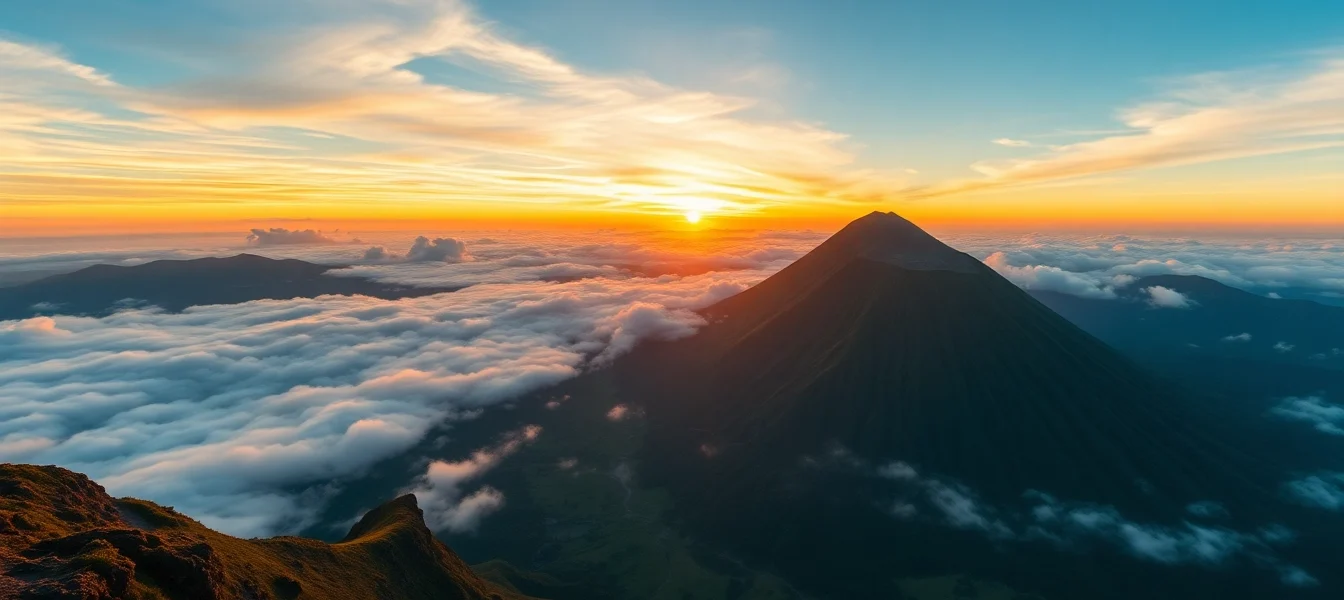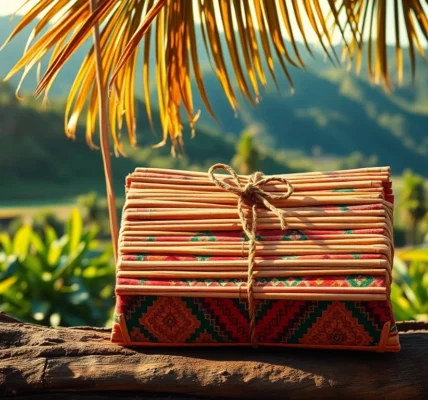Introduction to Mount Rinjani
Perched majestically on the island of Lombok in Indonesia, Mount Rinjani stands as one of Southeast Asia’s most iconic and awe-inspiring volcanic landmarks. As the second-highest volcano in Indonesia, Rinjani boasts a towering summit reaching 3,726 meters (12,224 feet) above sea level, offering a dramatic skyline visible from many parts of Lombok. Its significance transcends mere geological prominence; it holds immense cultural, spiritual, and ecological importance for local communities and international travelers alike. This article provides a comprehensive exploration of Mount Rinjani, delving into its geography, history, biodiversity, adventure opportunities, and practical travel guidance, serving as the ultimate guide for enthusiasts and casual visitors alike.
Location and Significance in Indonesia
Located within the boundaries of the Gunung Rinjani National Park, Mount Rinjani is positioned in North Lombok, Nusa Tenggara Barat (NTB) Province. Its strategic position on Lombok makes it not only a prominent natural feature but also a vital part of Indonesia’s volcanic arc, which extends along the Pacific Ring of Fire. The volcano’s strategic and cultural importance is rooted in its role as a UNESCO-recognized biodiversity hotspot and a sacred mountain for the Sasak, Lombok’s indigenous people, who have revered it for centuries. The mountain’s presence influences local climate, agriculture, and spiritual traditions, making it an integral part of Lombok’s identity.
Historical and Cultural Background of Rinjani
Ancient Eruptions and Geologic History
Mount Rinjani has a complex and dynamic volcanic history dating back thousands of years. Its most notable eruption occurred in 1257, originating from the caldera-forming eruption of Mount Samalas, a volcano that predated Rinjani and is considered a precursor to current activity. This historic event is believed to have caused a climatic cooling effect, impacting global weather patterns and contributing to the ‘Little Ice Age.’ Subsequent eruptions have shaped the landscape, creating fertile volcanic soils that support diverse ecosystems.
Cultural Significance and Local Legends
The mountain is deeply embedded in Lombok’s cultural fabric. It is considered a sacred site by local communities, with numerous myths, legends, and traditional rituals associated with its peaks. The Sasak people hold annual ceremonies at the foot of the mountain, seeking blessings for good harvests and protection from natural calamities. Notably, Rinjani is linked to the legend of Mount Samalas, believed to be the spiritual home of spirits and ancestors, emphasizing its spiritual potency.
Why Mount Rinjani Is a Must-Visit Attraction
Mount Rinjani offers a multifaceted allure for adventurers, nature lovers, and cultural travelers. Its imposing silhouette serves as a backdrop to a variety of activities, from challenging treks to serene spiritual retreats. The volcano’s panoramic views of Lombok’s coastlines, neighboring islands, and the surrounding biodiversity hotspot create an irresistible appeal. Whether seeking adrenaline rushes or tranquility, visitors gravitate towards Rinjani to witness its stunning landscapes, explore unique ecosystems, and immerse in Lombok’s rich cultural tapestry.
Exploring the Rinjani National Park
Flora, Fauna, and Biodiversity
The national park encompassing Mount Rinjani spans over 41,330 hectares and is a biodiversity treasure trove. It features a wide range of flora, including endemic orchids, towering dipterocarps, and lush bamboo groves. The park’s fauna is equally rich, with species such as the Java monkey, flying foxes, eagles, and the rare Rinjani scops owl. Its ecosystems range from montane forests at lower elevations to alpine mosses near the summit, offering habitats for both endemic and migratory species. Conservation efforts are ongoing to protect these unique habitats amidst increasing tourism pressures.
Major Natural Attractions within the Park
Beyond its volcanic core, Rinjani National Park boasts several natural attractions that draw visitors into its embrace. The Segara Anak Crater Lake stands out as a stunning volcanic lake nestled within the caldera, offering opportunities for boat riding and fishing. Rinjani Waterfalls, such as Sendang Gila, provide scenic escapes with cascading waters and lush surroundings. Other highlights include the hot springs of Banjar and picturesque camping sites at Senaru and Sembalun, ideal for those seeking an immersive experience in nature.
Conservation Efforts and Eco-Tourism
Protecting Mount Rinjani’s delicate ecosystems is a shared responsibility among local authorities, environmental groups, and tourism operators. Initiatives focus on promoting sustainable tourism practices, waste management, and community involvement. Guidelines encourage trekkers to minimize environmental impact by adhering to ‘Leave No Trace’ principles and supporting local eco-friendly accommodations and services. Education programs aim to raise awareness about conservation, ensuring that Rinjani remains a pristine natural wonder for generations to come.
Mount Rinjani Trekking and Adventure Activities
Popular Hiking Routes and Difficulty Levels
Mount Rinjani offers several trekking routes catering to various skill levels, with Sembalun and Senaru being the primary entry points. The Sembalun trail, approximately 27 km in length, is favored for its relatively gentle ascent and scenic landscapes, whereas the Senaru route provides a more challenging but equally rewarding experience. Trekking to the summit typically takes 2-3 days, with options for extended multi-day adventures. The terrain varies from lush forests to rocky volcanic slopes, testing the endurance and resilience of climbers.
Tips for a Successful Trekking Experience
Preparation is crucial for conquering Rinjani’s diverse terrains. Proper physical conditioning, acclimatization, and packing the right gear—warm clothing, sturdy hiking boots, headlamps, and climbing gloves—are essential. Hydration and nutrition supplies should be prioritized, alongside a basic first aid kit. It is advisable to start your trek early in the morning to avoid afternoon weather changes and to pace yourself to mitigate altitude sickness. Always check weather forecasts and park alerts, as volcanic activity can influence safety protocols.
Guided Tours and Preparation Essentials
Engaging with reputable guided tour operators enhances safety and enriches the experience. Guides provide valuable knowledge about the mountain’s geology and culture, assist with navigation, and ensure adherence to park regulations. Many tour packages include permits, porters, and camping equipment rental, relieving trekkers of logistical burdens. Prior to embarking, ensure your physical fitness, check equipment condition, and familiarize yourself with emergency procedures. Local guides and agencies also focus on responsible tourism, maintaining the ecological integrity of the mountain.
Scientific and Geological Insights
Volcanic Activity and Eruption History
Mount Rinjani remains an active volcano with periodic eruptions and geothermal activity. Its last significant eruption occurred in 2016, prompting temporary hikes and park closures. The volcano’s activity is monitored closely by Indonesian geological agencies using seismographs, gas emission sensors, and satellite imagery. The volcanic activity has historically shaped the landscape, creating fertile volcanic soils and lava fields, and contributing to the region’s dynamic geology.
Monitoring and Safety Measures
Given its active status, safety is a primary concern for visitors. The park authorities maintain a comprehensive monitoring system, issue eruption alerts, and establish exclusion zones. Trekkers are advised to heed official warnings and stay informed through updates from the National Park’s management. Emergency evacuation plans are in place, and guides are trained to respond swiftly to signs of volcanic unrest. Visitors are encouraged to carry proper safety gear and to have travel insurance covering potential volcanic developments.
Educational and Research Opportunities
Rinjani serves as an important site for scientific research into volcanic activity, biodiversity, and climate change. Universities and research institutions conduct ongoing studies to understand its eruption patterns, ecological resilience, and the impacts of climate variation. Educational programs and guided interpretive tours are designed to enhance visitors’ understanding of the mountain’s geoscience and ecological significance, fostering a deeper appreciation and stewardship of this natural wonder.
Travel Tips and Accommodations
Best Time to Visit Mount Rinjani
The optimal time to explore Mount Rinjani is during the dry season, from May to September, when weather conditions are most stable. During this period, clear skies and minimal rainfall enhance visibility and safety. The wet season, from November to April, brings increased rainfall, muddy trails, and higher risks of difficulty and accidents. Planning your trip within the dry months maximizes the chances for a successful and enjoyable adventure.
Local Culture and Nearby Attractions
Lombok’s vibrant culture offers a rich tapestry of traditions, crafts, and spiritual sites. After your Rinjani expedition, explore local markets in Mataram, visit traditional Sasak villages, and participate in cultural ceremonies. Nearby attractions include beautiful beaches like Senggigi, the Gili Islands renowned for snorkeling and diving, and the waterfalls of Sendang Gila. These offerings enrich your understanding of Lombok’s diverse natural and cultural heritage.
Where to Stay and Local Cuisine
From rustic homestays to luxury resorts, Lombok provides accommodations suited to all budgets. Many lodges and guesthouses near the park’s entry points offer convenient access to treks and local experiences. Savor Lombok’s unique cuisine, featuring dishes such as ayam taliwang (spicy grilled chicken), plecing kangkung (savory vegetable dish), and fresh seafood. Engaging with local culinary traditions not only enhances your visit but also supports community-based tourism initiatives.

